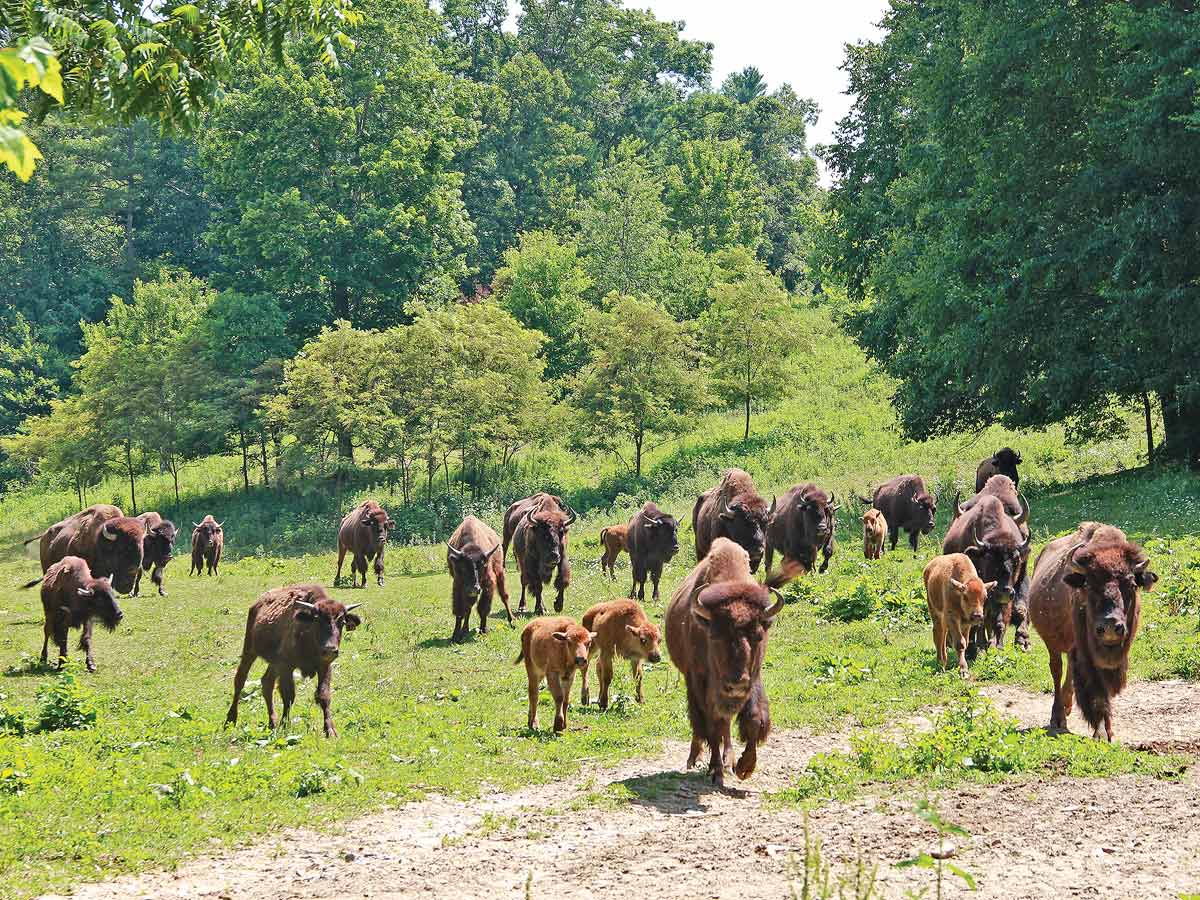Joining the herd: Family-run bison farm, vacation rental flourishes in Clyde
 The bison herd run in for feeding time. Buffalo Creek Vacations photo
The bison herd run in for feeding time. Buffalo Creek Vacations photo
When Cheryl Hillis started managing vacation rentals in Haywood County 15 years ago, Airbnb didn’t exist, reservations were made with phone calls and mailed checks, and she lived nowhere near Western North Carolina. Hillis was the face of Buffalo Creek Vacations, but she took reservations and managed payments from whichever town her military husband and their four boys lived at the time.
“Sometimes my husband would be deployed, and I had the boys,” she recalled. “I remember one time it was just nuts. They would be banging on the door for food, and I’d be in the pantry making a reservation the old-fashioned way.”
“We built this with a lot of sweat and love and hard work,” she added.
What Hillis — along with her parents, Harold and Harriet Clackett, husband Jeff and three brothers with their spouses — have built is Trinity Bison Ranch and Buffalo Creek Vacations, a 72-acre enclave in Crabtree that is part vacation destination, part working farm and part petting zoo.

- A mini donkey brays on an autumn afternoon. Holly Kays photo
‘We call him Noah’
While Hillis has long been the public face of the family business, the story started with her father Harold, who spent his working years as a UPS truck driver on Long Island, New York. When he retired, he wanted a change. In 1994, Harold and his wife Harriet moved down to Clyde.
Related Items
“He loved bison,” said Hillis. “He wanted to raise something American-made. So he built his house and got four bison.”
Ten years later, the 40 acres behind them came up for sale, and Harold quickly contacted his daughter and five sons, urging them to pool their money and help buy it. Of the six siblings, four opted in — setting the stage to expand the bison herd, build an ever-increasing number of cabins and acquire a growing roster of other farm animals. In 2005, Cheryl and Jeff invested five additional bison in the herd and in 2007 the first vacation rental opened.
“My dad, we call him Noah because he feels like he has to have every kind of animal,” Hillis said.
Currently, the farm is home not only to the bison herd, which now numbers 38 animals, but also alpacas, llamas, mini donkeys, horses, mini horses, goats, rabbits, chickens and a tom turkey. It also holds 10 cabins — that number is set to increase to 14 by the end of 2024 — and two luxury caboose rentals, with renovations underway on four more. Like the model train exhibit on the top floor of the main building, the renovated cabooses are a nod to Harold’s love of trains.
But the 38 enormous animals at the center of the property are the reason for it all. On Sept. 17, the herd welcomed the annual conference of the Eastern Bison Association, an event typically held further north.
“He (Harold) always just loved bison, and bison are our national mammal,” said Hillis. “He just wanted to preserve and protect them.”

- A mother alpaca sniffs her newborn baby. Cheryl Hillis photo
America’s national mammal
The American bison, the largest terrestrial animal in North America, once covered grasslands and prairies across the continent. With males weighing a ton or more, bison provided abundant and healthy meat to the Native American societies in their range, and their various body parts supplied materials for clothing, shelter and tools. Their populations reached into the tens of millions, but European Americans settling the western half of the continent in the 1800s saw the bison as an enemy supply line to be cut off. The U.S. Army launched a campaign to remove Native American tribes by exterminating bison, their main food source. By the late 1880s, the giant herds were nearly gone.
Today, about 30,000 bison live in public and private herds across the continent that are managed for conservation goals, according to the National Park Service — including the 2,300 to 5,500 that are part of the iconic Yellowstone National Park population. However, approximately 400,000 bison are raised as livestock, as is the case at Trinity Bison Ranch.
While the farm in Haywood County is thousands of miles away from the famed bison herds of Yellowstone and the Black Hills, hundreds of years ago the spot may well have housed native wild bison. The animals’ historical range was not relegated to the American West.
“The buffalo was certainly here long before the Cherokees emerged as a distinctive culture about a thousand years ago. They knew the great beast as ‘yansa,’ and utilized it for clothing and food,” naturalist George Ellison wrote in a 2010 column for The Smoky Mountain News. “According to Arlene Fradkin’s Cherokee Folk Zoology (N.Y.: Garland, 1990), the horns were made into surgical instruments for curing swellings from boils and toothaches as well as for war trumpets. Buffalo hoofs were sometimes worn on warriors’ feet during war expeditions so as to deceive the enemy. To this day the buffalo dance is still a favorite among the Eastern Band of Cherokee Indians.”
Most experts believe the bison had been extirpated — or made locally extinct — from the mountains of Western North Carolina by around 1865, Ellison wrote, adding that the last reference he could locate came from a 1752-53 diary kept by Bishop Augustus Gottlieb Spangenberg during an exploration of the Blue Ridge. Bison in the Smokies region were usually described as smaller and better adapted to woodland living than the western plains bison, but Ellison believes that the animals were more an ecological variant of the plains bison than a genetic one.
Genetically, the bison inhabiting farms like Trinity aren’t distant relatives of their wild cousins like horses and cows are from their wild predecessors, Hillis said. The bison live a domestic lifestyle, but they don’t have a domestic temperament.
“We don’t even pet them. We want to but we don’t,” said Hillis. “They are not aggressive, but they are wild animals.”
On roundup day, which typically takes place on Black Friday, the Clackett family gets about 10 people together to run the bison through the chute, tagging the calves, deworming the whole herd and identifying bulls for next year’s processing. It’s stressful, Hillis said, being that close to such enormous animals. You have to keep your wits about you.
“They don’t really paw the ground like cows or bulls, but when that tail goes straight up, that’s when they’re irritated, and they’re gonna charge you,” said Hillis. “We rarely see that here. Unless you make them mad, they’re just out in the pasture enjoying life.”

- Member of the Clackett family pose on one of the property’s caboose rentals. Buffalo Creek Vacations photo
Jumping in
Harold Clackett didn’t start the bison herd with the goal of producing meat, but as the herd grew processing became a necessity. The property can’t sustain uncontrolled growth. In 2015, the family started processing a few bison each year — currently, the annual number is four, typically bulls.
“If you don’t cull them out, they will,” Hillis said. “The bulls will kill each other off.”
Each year, they get six or seven calves from the females in the herd. After the bulls are sent off to the processor, they’ll buy some new animals to maintain the herd’s genetic diversity. The meat gets sold and served to the property’s guests, as well as at the Haywood’s Historic Farmers Market and in the Trinity Burger served at Furman’s Burger Bar in Waynesville. The farm also offers farm-fresh eggs and fiber products from the alpacas and llamas.
“We’re just a very small, family-run business,” Hillis said, “so we all jump in and have a part.”
Now, Hillis can play her part in person, rather than using phones and email to maintain her connection from some distant military base. After 27 years of service, Hillis’ husband Jeff retired to civilian life last year. The couple is building a house on the property, nestled amid the fields holding horses and alpacas.
As a 20-something Long Islander helping her dad get the vacation rental business off the ground, Hillis was skeptical of the whole endeavor. Who would come out to Clyde, North Carolina, to sleep in a cabin hidden up a gravel mountain road?
Lots of people, it turns out. The cabins and cabooses are frequently full, especially during leaf season. And while Hillis’ days are busy with answering phones, helping guests and managing the business, just outside the door is the menagerie of animals and the natural beauty that draws millions of people to the mountains each year. Ultimately, it drew Hillis too.
“I love the country,” she said. “I love living here.”









